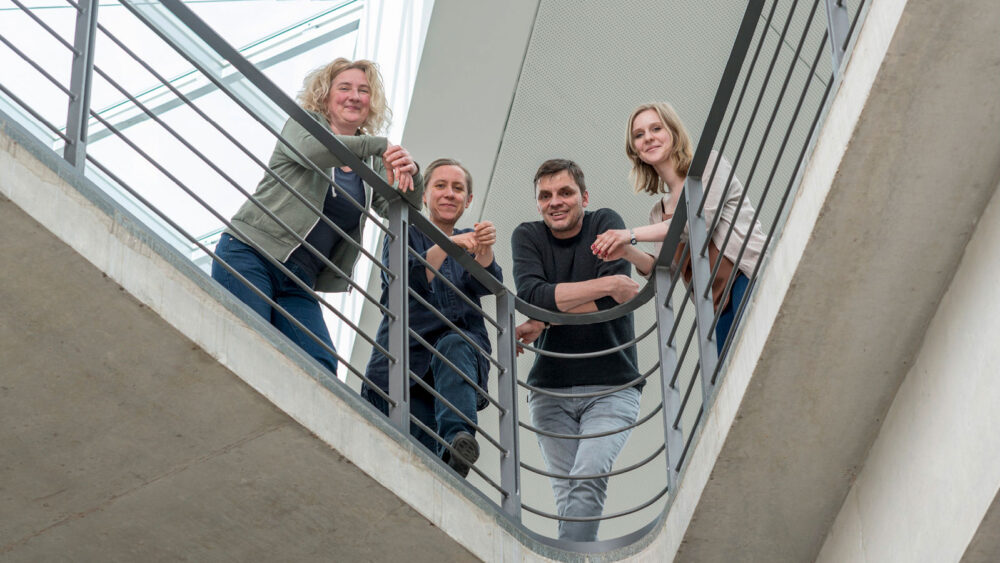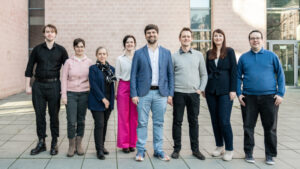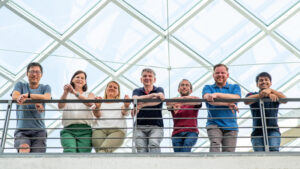

Immune Monitoring
In Search of Cell Patterns in Blood for Individualised Medicine
Immune monitoring is generally understood to be the combination of various diagnostic procedures intended to provide information on the immune status of a patient. Depending on the clinical application, humoral factors such as cytokines, antibody titres or complement factors; the cellular composition of peripheral blood; functional-cellular parameters; or rather a combination of them all can be determined. A prerequisite for disease and/or therapy specific immune monitoring is the identification of suitable biomarkers, which can be qualitatively and quantitatively measured at the individual cell level, for example by flow cytometry. The development of such biomarkers is as time-consuming as the development of new drugs. New biomarkers are urgently needed, especially in connection with the much praised concept of precision medicine, which promises to be able to offer patients tailored therapy options.
Successful examples of cell-based monitoring are the measurement of plasmablasts or monocytes expressing the adhesion molecule Siglec-1 in systemic lupus erythematosus (SLE). Both parameters correlate well with the disease activity of SLE patients. In particular, Siglec-1, which serves as a surrogate marker for an activated type I interferon system, has undergone extensive validation studies and is now part of the portfolio of the diagnostic laboratory of the Charité, the “Labor Berlin”. Due to the technical possibilities offered by state-of-the-art analytical flow cytometers, up to 30 different fluorochromes can be determined simultaneously. Thus, the expression of many antigens can be determined qualitatively and quantitatively in a single measurement.
Furthermore, mass cytometry (CyTOF technology) offers a new dimension in multiparametric single cell analysis. CyTOF technology combines single-cell cytometry and mass spectroscopic analysis of heavy metal ions, which are used instead of fluorescence molecules to label antibodies. Theoretically, up to 120 parameters per cell can be measured. In practice, up to 45 measurement parameters are currently combined. In addition to several technological developments that were necessary to standardise mass cytometry to such an extent that it can also be used for immune monitoring in clinical studies, various interdisciplinary studies on different clinical issues have already been initiated. In particular, the Leibniz ScienceCampus Chronic Inflammation, which was established in 2016, has the goal of conducting interdisciplinary research on chronic inflammatory mechanisms. In addition to the purely phenotypic analysis of leukocyte subpopulations, comparative mass cytometric analyses will also be used to investigate the activation status of leukocyte subpopulations by monitoring phosphorylated signaling molecules.
Keywords
Biomarker
Personalized medicine
Type I interferon signatures
Mass cytometry
Immunophenotyping

Group leader
Dr. rer.nat. Andreas Grützkau
PhD student
Marie Burns
- PD Dr. med. T. Häupl, Charité – Universitätsmedizin Berlin
- Dr. med. U. Syrbe, Charité – Universitätsmedizin Berlin
- Prof. Dr. med. D. Poddubnyy, Charité – Universitätsmedizin Berlin
- Dr. med. R. Biesen, Charité – Universitätsmedizin Berlin
- Dr. med T. Rose, Charité – Universitätsmedizin Berlin
- Dr. med. M. Bertolo, Charité – Universitätsmedizin Berlin
- Prof. Dr. med. M. Worm, Charité – Universitätsmedizin Berlin
- PD Dr. med. E. Philipp, Charité – Universitätsmedizin Berlin
- PD Dr. T. Alexander, Charité – Universitätsmedizin Berlin
- Dr. rer. nat. Bruno Stuhlmüller
- Dr. rer. nat. B. Smiljanovic, Charité – Universitätsmedizin Berlin
- Dipl.-Math. T. A. Sörensen, Charité – Universitätsmedizin Berlin
- Dr. S. Holtze, IZW-Berlin
- Prof. T.B. Hildebrandt, IZW-Berlin
- Prof. Dr. med. G. Heine, Uniklinik Kiel
- PD Dr. med. K. Aden, Uniklinikum Kiel
- Dr. Florence Apparailly, INSERM u1183, Montpellier, France
- Dr. rer. nat, U. Baron, Epiontis GmbH, Berlin
- Dr. rer. nat. S. Olek, Epiontis GmbH, Berlin
- Dr. rer.nat. A. Briel, NanoPET GmbH, Berlin
- Martina Bertolo, Sabine Baumgart, Pawel Durek, Anette Peddinghaus, Henrik Mei, Thomas Rose, Philipp Enghard, Andreas Grützkau. Deep phenotyping of urinary leukocytes by mass cytometry reveals a leukocyte signature for early and non-invasive prediction of response to treatment in active lupus nephritis. Front. Immunol. 2020, in press
- López-Serrano Oliver A, Haase A, Peddinghaus A, Wittke D, Jakubowski N, Luch A, Grützkau A, Baumgart S. Mass Cytometry Enabling Absolute and Fast Quantification of Silver Nanoparticle Uptake at the Single Cell Level. Anal Chem. 2019 Sep 6. doi: 10.1021
- Shebzukhov Y, Holtze S, Hirseland H, Schäfer H, Radbruch A, Hildebrandt T, Grützkau A. Identification of cross-reactive antibodies for the detection of lymphocytes, myeloid cells and haematopoietic precursors in the naked mole rat. Eur J Immunol. 2019 Jul 26.
- Schulte-Wrede U, Sörensen T, Grün JR, Häupl T, Hirseland H, Steinbrich-Zöllner M, Wu P, Radbruch A, Poddubnyy D, Sieper J, Syrbe U, Grützkau A. An explorative study on deep profiling of peripheral leukocytes to identify predictors for responsiveness to anti-tumour necrosis factor alpha therapies in ankylosing spondylitis: natural killer cells in focus. Arthritis Res Ther. 2018 Aug 29;20(1):191.
- Baron U, Werner J, Schildknecht K, Schulze JJ, Mulu A, Liebert UG, Sack U, Speckmann C, Gossen M, Wong RJ, Stevenson DK, Babel N, Schürmann D, Baldinger T, Bacchetta R, Grützkau A, Borte S, Olek S. Epigenetic immune cell counting in human blood samples for immunodiagnostics. Sci Transl Med. 2018 Aug 1;10(452). pii: eaan3508.
- Smiljanovic B, Radzikowska A, Kuca-Warnawin E, Kurowska W, Grün JR, Stuhlmüller B, Bonin M, Schulte-Wrede U, Sörensen T, Kyogoku C, Bruns A, Hermann S, Ohrndorf S, Aupperle K, Backhaus M, Burmester GR, Radbruch A, Grützkau A, Maslinski W, Häupl T. Monocyte alterations in rheumatoid arthritis are dominated by preterm release from bone marrow and prominent triggering in the joint. Ann Rheum Dis. 2018 Feb;77(2):300-308.
- Strauß R, Rose T, Flint SM, Klotsche J, Häupl T, Peck-Radosavljevic M, Yoshida T, Kyogoku C, Flechsig A, Becker AM, Dao KH, Radbruch A, Burmester GR, Lyons PA, Davis LS, Hiepe F, Grützkau A, Biesen R. Type I interferon as a biomarker in autoimmunity and viral infection: a leukocyte subset-specific analysis unveils hidden diagnostic options. J Mol Med (Berl). 2017 Mar 29.
- Rose T, Grützkau A, Klotsche J, Enghard P, Flechsig A, Keller J, Riemekasten G, Radbruch A, Burmester G-R, Dörner T, Hiepe F and Biesen R. Are interferon-related biomarkers advantageous for monitoring disease activity in SLE? A longitudinal benchmark study. Rheumatol. 56 (9), 1618-1626
- Rose T, Szelinski F, Lisney A, Reiter K, Fleischer SJ, Burmester GR, Radbruch A, Hiepe F, Grützkau A, Biesen R, Dörner T. SIGLEC1 is a biomarker of disease activity and indicates extraglandular manifestation in primary Sjögren’s syndrome. RMD Open. 2016 Dec 30;2(2):e000292.
- Sörensen T, Baumgart S, Durek P, Grützkau A, Häupl T. immunoClust–An automated analysis pipeline for the identification of immunophenotypic signatures in high-dimensional cytometric datasets. Cytometry A. 2015 Jul;87(7):603-15.
- Rsk2 controls synovial fibroblast hyperplasia and the course of arthritis.Derer A, Böhm C, Grötsch B, Grün JR, Grützkau A, Stock M, Böhm S, Sehnert B, Gaipl U, Schett G, Hueber AJ, David JP. Ann Rheum Dis. 2016 Feb;75(2):413-21. doi: 10.1136/annrheumdis- 2014-205618.

 Deutsch
Deutsch
